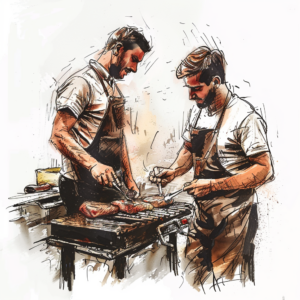
Back when the Prius and other hybrids went on the market, some anti-environmentalists expressed their opinion by rolling coal (humorously dubbed “Prius repellent”). The animosity against hybrids seemed to fade somewhat but the arrival of commercially viable electronic vehicles has sparked a new current of anger.
I first noticed this on Facebook in the form of cartoons and memes posted about EVs. The cartoon usually showed an EV with an extension cord connected to a smoke-belching powerplant and the memes made a similar point. This struck me as odd since I knew the people doing the posting were generally pro-fossil fuel, anti-renewable energy, and skeptical about climate change. Given their professed views, if electric vehicles ran on electricity generated by dirty fossil fuels, that should either be a matter of no concern or even a plus.
While I have seen people posting in a similar manner against renewable energy, after Trump (a noted hater of wind turbines), I noticed posts attacking wind power on the grounds that it kills birds. When posted by people who never showed any other concern for the environment, this also seemed odd.
Most recently, I have seen posts critical of electric cars and electric stoves that reference the sorry state of the American electrical system. This also seemed odd, since improving the electrical grid never seemed to concern these folks in the past.
Given that these posts on social media were consistent in their posting points and they occurred at roughly the same time, I decided to determine what was behind this. I also wanted to investigate the facts of the matter. This led me away from cartoons and memes to in depth and often thoughtful writing. I’ll start by looking at EVs.
The cartoons showing EVs linked to smoking powerplants do draw attention to a real concern and there are at least two other major concerns about these vehicles. Tilak Doshi, who “worked in the oil and gas sector as an economist in both private industry and in think tanks” wrote an informative essay for Forbes about the dirty secrets of EVs. While you should read the article for the details, he raises three main concerns about EVs.
The first is that the manufacture of an EV will typically result in significantly more environmental harm than the manufacture of a comparable fossil fuel burning vehicle. This disparity arises largely from the batteries used in the EV. As the media outlets who got the memo have hammered home, the batteries in EV are their dirty secret. Getting back to the cartoons I mentioned, Doshi also points out that if an EV gets its electricity from a dirty power source, like a coal-fired power plant, then it can be meaningfully more polluting than a conventional vehicle. Third, Doshi points out a problem that has been well known in the broader technology context for a long time: the mining of lithium is linked to significant harms to people beyond the environmental damage.
While I am not an expert on any of this, these claims are supported by reputable sources across the political spectrum. As such, I agree that the manufacture of these EVs is currently more polluting than manufacturing conventional vehicles, although this is clearly something that can be addressed. I also agree that powering EVs (or anything else) from dirty fossil fuel sources is a harmful way to generate electricity. And, of course, the human cost behind the manufacturing of these batteries is high and needs to be addressed. Now, let us move on to wind turbines and solar.
Trump, who hates wind turbines, consistently makes the true claim that windmills kill birds. Studies from 2013 and 2014 estimated that they killed 140,000 to 679,000 birds. The number killed is presumably higher now, due to an increase in wind turbines. As noted above, many people who oppose renewable power use the death of birds as a premise in their argument against it. They also refer to, correctly, that solar and wind power come with manufacturing and disposal issues that cause environmental harm.
While not an expert on wind turbines and solar power, these claims are well supported and I have no reason to doubt that wind turbines kill birds or that renewable energy creates an environmental impact—after all, these turbines and panels need to be manufactured and eventually disposed of.
While some people might be tempted to reject claims from Trump and others who oppose renewable energy because they do not like these people, that would be a mere ad hominem. Also, to reject what people connected to the fossil fuel industry say about EVs and renewables because they have a stake in the matter would be another mere ad hominem. One should, of course, be wary of bias but this is not proof that someone is wrong. Likewise, if someone profits from EVs or renewable energy or is associated with them, it does not follow that they are wrong in their claims. That said, this approach taken to criticize EVs and renewables has made me both suspicious and curious. After all, these seem to be what are usually liberal arguments grounded on what appears to be professed concern about the environment, climate change, human rights, and worker exploitation. Why would, for example, a person known to be pro-fossil fuel, anti-renewable energy, and skeptical about climate change post a cartoon that seems to be criticizing EVs on the grounds that they contribute to fossil fuel pollution? Why would people with links to the fossil fuel industry make such arguments against EVs and renewable energy? Why would people who normally seem to lack concern about energy generation killing birds be so concerned about bird deaths? While one can never know for sure what is in another’s mind, there are certainly reasonable claims that can be made.
One hypothesis is that these people do have concerns about the environment (and human rights) but the scope of their concern is extremely narrow. That is, they are only concerned about the environmental (and human) harm caused by EVs and renewable energy.
The fact that wind generated energy kills 0.269 birds per gigawatt-hour of electricity produced, compared to 5.18 birds killed per gigawatt-hour of electricity from fossil fuel projects does not concern them. We do not, for example, see Trump lamenting the birds killed by fossil fuel projects.
The fact that expanding public transportation and redesigning cities would reduce the need for both EVs and conventional cars does not seem to concern them, for they seem laser focused on the pollution created by EVs. Also, those posting the power plant cartoons do not post cartoons showing these EVs connected to renewable energy—something that would seem to address their criticism of EVs running on dirty power. Those rightly pointing out that the awful US power grid and the wiring of many houses will not be able to handle an increase in EVs and electric stoves do not mention that this challenge can be addressed with renewable energy and a meaningful investment in public infrastructure.
It is certainly possible that these people are making a good faith criticism of EVs and renewable energy based on their very focused and limited concern about the harm done by EVs and renewable energy. But this seems like a rather odd view; like only being concerned about deaths caused by colon cancer and having no concerns about all other cancers (and worse, being a proponent of some other types of cancer). After all, if the harm caused by EVs and renewable energy are bad, these same harms produced by conventional vehicles and fossil fuels would also be bad. But perhaps these folks do not have a narrow scope of concern; perhaps this is a rhetorical tactic being used against people who are more broadly concerned about the environment and harm to humans. This tactic can be called a “false concern argument.”
A false concern argument involves using as a premise or premises (which might be unstated) a concern that the person making the argument does not have and doing this in bad faith. While it is reasonable to craft an argument that will appeal to the concerns (and values) of your target audience, the problem with the false concern argument is the bad faith aspect: the person making the argument does not share the concern that they are intentionally exploiting in the argument.
Going back to the EV cartoons and other criticisms of EVs, the implicit argument seems to be as follows: Because EVs are recharged from electricity generated by dirty fossil fuel plants, they are not good for the environment. Since you (the target of the cartoon) care about the environment, you should not buy an EV (or you should oppose them). Likewise for arguments involving the harms stemming from their manufacture.
In the case of wind and solar, the argument is built around the idea that because of the harm to birds (wind) and the environment (both), people concerned about birds and the environment should oppose solar and wind.
If we consider only the arguments in isolation, the reasoning can be good, and the premises can be plausible. As noted above, there are real concerns about EVs and renewable energy that give a person who cares about the environment (and people) reasons to be concerned about both. That said, someone who is concerned about the environment (and people) would also consider ways in which these real harms could be mitigated (such as recycling batteries) and would also compare these harms to those generated by the alternatives (such as fossil fuel energy). We can and should have good faith discussions about the harms of EVs and renewable energy. But bad faith cartoons, essays and arguments do not help.
As also noted above, rejecting these criticisms because of who makes them or because they are believed to be acting in bad faith would be to fall into fallacious reasoning. But what, then, is my criticism of these bad faith arguments and what is the problem with false concern arguments?
In terms of why these posts and arguments are in bad faith, there is the fact that they are generally made by people who are generally pro-fossil fuel, anti-renewable energy, and skeptical about climate change. They also usually do not seem overly concerned about birds in other contexts. Also, many criticisms of EVs and renewables comes from people in the fossil fuel industry and those who are paid to protect it. Again, this does not mean that their arguments are wrong, it is just that they are unlikely to be making these arguments from an anti-fossil fuel, pro-renewable energy, climate-change accepting world view. That is, they are most likely not concerned about fossil fuel pollution, climate change, etc. If they were, they would post and make criticisms about fossil fuel-based pollution and not limit their concern to EVs and renewable energy. This is to say, they do not have the concerns that their cartoons and arguments rest upon—they do not believe their own key premise(s). The person who posts the cartoon of the EV is most likely not opposed to the fossil fuel plant in their cartoon—they do not, for example, post critical cartoons of conventional cars driving past oil refineries and oil leaks from ships, wells, trains, and pipelines. What, then, are they doing?
A somewhat lazy explanation is that the cartoon posters and others are trying to “own the libs” by shoving in their faces the fact that EVs are a source of pollution. Liberals are supposed to love EVs and renewables, so this is a way to mock them. This does have some appeal as an explanation in some cases, but does not explain well written attacks on EVs that lay out evidence and maintain a reasonable tone.
While this is speculation, they seem to be well-crafted bad faith arguments intended to persuade pro-EV and pro-renewable energy people to change their minds in favor of conventional vehicles and fossil-fuel. Or at least raise doubts. I say they are (probably) bad faith because they make their case by writing as if environmental harm is bad (when caused by an EV or renewables), but do not extend this principle to fossil fuels and conventional vehicles. For example, Tilak Doshi offers an in depth criticism of EVs, but if you look at his other essays he does not offer such harsh criticism on the same principles of conventional vehicles (or fossil fuels). In this case, the problem with their bad faith argument is, once again, that they do not seem to believe what they are arguing.
Fairness does require that I consider an alternative: they are not basing their arguments on a professed or implied false concern but are trying to prove to supporters of EVs and renewable energy that these are bad like conventional cars and fossil fuels. That is, they all do harm to the environment and people.
But this also leads to an obvious question: if they believe that EVs and renewable energy are bad like conventional vehicles and fossil fuels, why would they oppose them, given that they are not seem concerned with these harms? After all, if a coal-fired plant does not bother a person, then an EV powered by that plant should not bother them either. If fossil fuel plants killing more birds than wind power does not bother them, why should wind turbines killing fewer birds bother them? If the harm to people from the fossil fuel industry does not concern them, why should this harm concern them when it comes to EVs and renewable energy? As such, the harm arguments they make would seem to be in bad faith—they do not seem to care about the harms. Given this, a reasonable explanation is that one motivating factor behind these criticisms (and the cartoons arising from them) is that it is an attempt by the fossil fuel industry to harm a competing industry through a propaganda campaign. This campaign does seem to be having some effect, if only in the proliferation of attacks on EVs and renewable energy on social media.
 While it might seem odd, the debate over the ethics of eating meat is an ancient one, going back at least to Pythagoras. Pythagoras appears to accept reincarnation, so a hamburger you eat be from a cow that had the soul of your reincarnated grandmother. Later philosophers tended to argue in defense of eating meat, although they took the issue seriously. For example, Augustine considered whether killing animals might be a sin. His reasoning, which is still used today, is based on a metaphysical hierarchy. God created plants to be eaten by animals and animals to be eaten by humans. This conception of a hierarchical reality is also often used to defend the mistreatment of humans. Saint Thomas also considered the subject of killing animals, but ended up agreeing with Augustine and arguing that the killing of an animal is not, in itself, a sin.
While it might seem odd, the debate over the ethics of eating meat is an ancient one, going back at least to Pythagoras. Pythagoras appears to accept reincarnation, so a hamburger you eat be from a cow that had the soul of your reincarnated grandmother. Later philosophers tended to argue in defense of eating meat, although they took the issue seriously. For example, Augustine considered whether killing animals might be a sin. His reasoning, which is still used today, is based on a metaphysical hierarchy. God created plants to be eaten by animals and animals to be eaten by humans. This conception of a hierarchical reality is also often used to defend the mistreatment of humans. Saint Thomas also considered the subject of killing animals, but ended up agreeing with Augustine and arguing that the killing of an animal is not, in itself, a sin.
 Being nerdtastic by nature, my nerd sense picks up disturbances in nerd culture. One of the loudest types of disturbances is when people express outrage at gender and race swapping involving established characters.
Being nerdtastic by nature, my nerd sense picks up disturbances in nerd culture. One of the loudest types of disturbances is when people express outrage at gender and race swapping involving established characters.  The original Mary Sue was created in 1973 by Paula Smith as a parody of Star Trek fan fiction. A Mary Sue character is usually presented as inexplicably competent, possessing special talents or powers, enjoying the admiration of others, lacking in weaknesses and flaws, attractive, and virtuous. A Mary Sue is usually a young woman, but there are male versions called “Gary Stu” or “Marty Stu.”
The original Mary Sue was created in 1973 by Paula Smith as a parody of Star Trek fan fiction. A Mary Sue character is usually presented as inexplicably competent, possessing special talents or powers, enjoying the admiration of others, lacking in weaknesses and flaws, attractive, and virtuous. A Mary Sue is usually a young woman, but there are male versions called “Gary Stu” or “Marty Stu.” Not so long ago, diversity in works of art was criticized as the result of political correctness (PC). The current manifestation of this criticism targets Diversity, Equity, and Inclusion (DEI) Such criticisms can be about the content of the work, about the casting, or about the people involved in the creation of the work.
Not so long ago, diversity in works of art was criticized as the result of political correctness (PC). The current manifestation of this criticism targets Diversity, Equity, and Inclusion (DEI) Such criticisms can be about the content of the work, about the casting, or about the people involved in the creation of the work.
